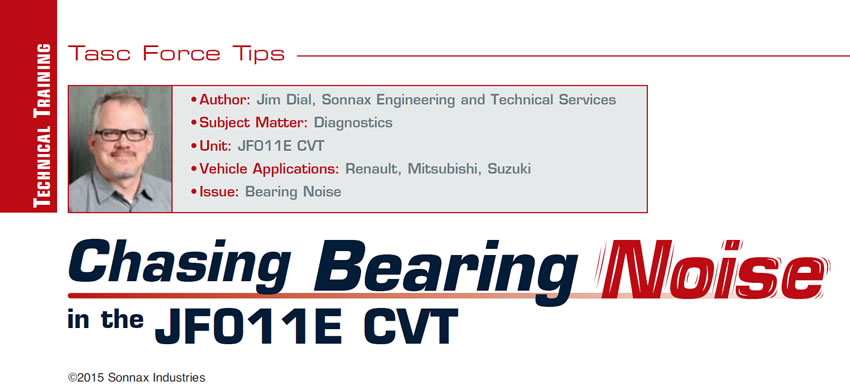March 2015 Issue
In This Issue
Land Rover Bearing Noise
Chevy 2500 Truck Adapter Failure
6T70/6F50 Transmission End Covers
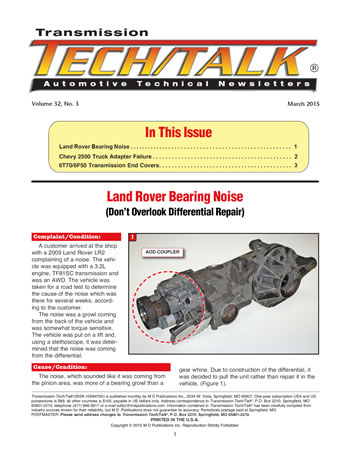
(Avoid a Square Peg in a Round Hole)
Who knew back in 1989 when the E4OD was launched what the time-frame footprint would be or how many changes would occur, let alone that it would grow into a five speed automatic?
For the repair industry, the big RWD family of transmissions has been pretty profitable due to failures, but at times somewhat troublesome due to rebuilding issues and component upgrades. Some upgrades have been fairly straightforward and inexpensive while others were more complex and costly. The four speeds certainly had modifications and upgrades; however, those models pale in comparison to the five speeds.
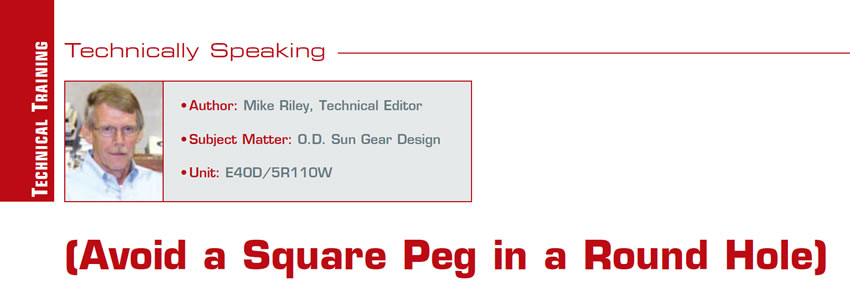
Telephone Procedure Dos and Don’ts
I began investigating how to maximize leads in today’s shops last year by interviewing some online lead experts, since that is where all the leads are nowadays. The common opinion in their line of work was that they would be a lot more successful if the managers in our industry knew how to answer the phone properly and convert their leads into jobs. I know there is a lot of truth in that because I have listened to recordings of my managers and when I saw them next, it was all I could do to keep my hands off their throats; however, there are a lot of managers out there in our industry that are trained on proper telephone procedure and know how to set a lead. The lead guys like them. Good salesmen make them look good. But, on the other hand, a good lead guy can make a salesman look good too.
THE MOVE FROM HELL
Moving is never easy, especially when it’s half way across the country to a place you’ve only visited a couple of times. Uprooting your family and changing your lifestyle from one that you’ve known for most or all of your life can be traumatizing. I’ve always prided myself in being adaptable and I’m sure I’ll get used to my new surroundings quickly but that wasn’t nearly my biggest problem with this move.
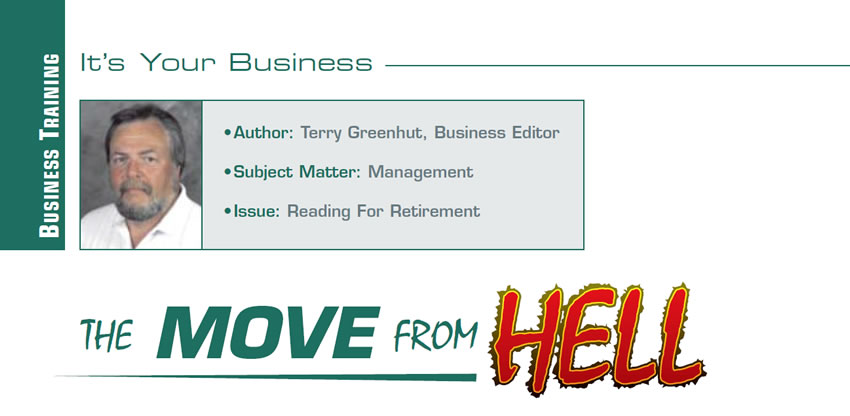
Vacuum Testing Aisin AW TF-60SN, BMW 6F21WA & VW/Audi 09G, 09K, 09M
From the TASC Force we reprint a series of in-depth test instructions for checking the serviceability of valve bodies.

CAN U Communicate?
By now, most of us have had to deal with a CAN (Controller Area Network) communication “U” series code at one time or another. Most of the time, diagnosing one these codes is fairly straightforward, given all of the articles and technical publications that have been written regarding these problematic codes. In most cases, it just comes down to identifying the module that isn’t communicating with the other modules on the CAN bus line for whatever reason. Generally, it’s some type of lost voltage or a poor ground in the circuit wiring to the module in question. So, what happens when all your diagnostic tests and checks take you down a dead-end road, and the actual problem ends up being a component that shouldn’t have had anything to do with a communication error code? I’m sure there may be a few engine drivability techs out there who have run into the situation that I’m about to cover, but it was a first for me.
A Frustrating Problem or a Normal Condition?
We recently had a customer come into our shop with a 2005 Jeep Grand Cherokee. He was very frustrated because he had taken his Jeep to a couple of repair shops as well as a local dealership but they hadn’t been able to correct the problem. The Jeep had a binding condition (described as “grinding” by the customer) in tight turns when it was cold.
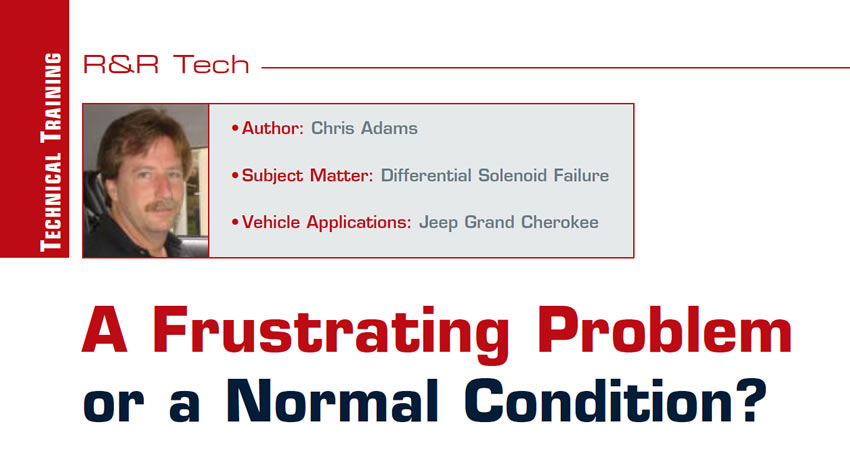
February 2015 Issue
In This Issue
GM 2ML70 Idle Bump
VW Eurovan Repair Gets Real
Allison 1000 Erratic Shifting/Lockup
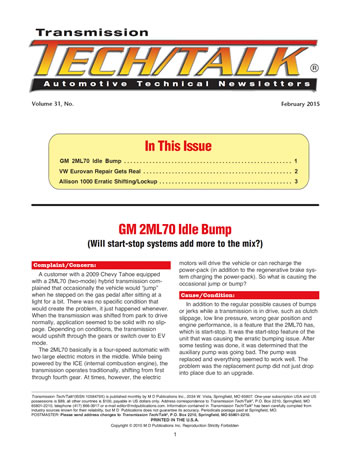
Maximizing Your Return On Tech Calls: Work Smarter, Not Harder
Our industry has morphed into an extremely complex diagnostic and troubleshooting environment. The current design and operation of modern vehicles has become as technical as rocket science. The relationship between the systems that interact to make the vehicle function correctly has grown to a point where even a road test can be very time consuming. Is the problem in the transmission, transfer case or rear? Are there multiple problems that affect inter connected systems or is the problem outside the transmission? To get a proper solution to a complex problem, we need to use a diagnostic routine that follows a set of protocols in a proper order that are structured to be consistent, every time without variation. Working from a consistent structure will prepare you for success without multiple phone calls and wasted time.

What We Want and What We Need
As much as we get used to what we are doing on a daily basis, sometimes the way we do it needs to change as conditions around us do or when we realize that what we’ve been doing just doesn’t get the job done anymore.
Marketing is one area in which this might hold true above all others. It’s just too easy to fall into the trap that “the way we’re doing it must be alright because it’s the way we’ve always done it.” Look around you. Nothing is the way it used to be–especially not the way you receive or convey information–and isn’t that what marketing and advertising are all about? Your message may not have changed very much because you still want to offer your excellent services to the public, but the way you deliver the message certainly has, and the types of offerings you put out need to make sense to your potential customers. Customers have to see your offer and immediately say to themselves, “I need that.”–not “I want it”, but “I need it.”

Ford Fusion Harsh 5th Gear (Avoiding: Failure to Communicate)
A customer with a 2010 Ford Fusion was experiencing erratic harsh upshifts into 5th and sometimes 6th gear. The vehicle was equipped with a 3.0L engine, 6F35 transmission and had 58,000 miles on it. There were no trouble codes; however, the problem was getting progressively worse. The other gear ranges seemed okay and the fluid was in fairly good condition.
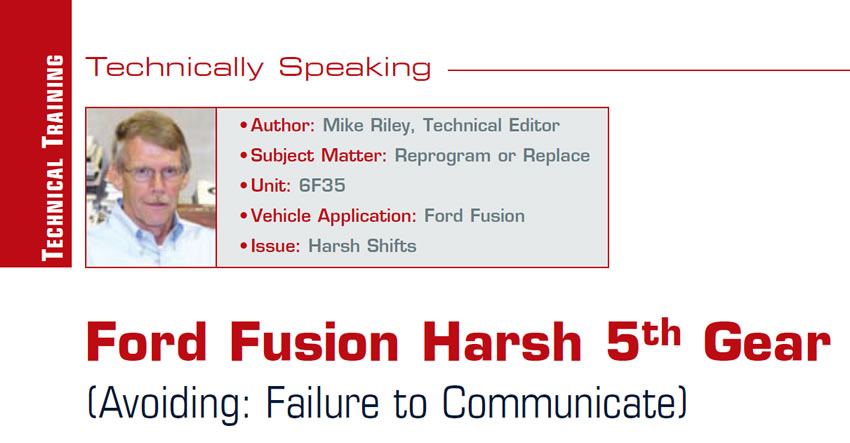
Chasing Bearing Noise in the JF011E CVT
Bearing noises can be difficult to track down even in familiar transmissions which we work on daily. The advantage of the familiar is that we know how to take these units apart and have a general idea of power flow and overall operation–plus, we typically have plenty of extra pieces on the shelf should we need them. Bearing noises in the CVT transmission are much harder to deal with, because we’re not as familiar with it as the units rolling in the door on a daily basis and spare CVT pieces are pretty much non-existent. This has created some minor paranoia when it comes to taking on a CVT repair. Hopefully this article will dispel a bit of the apprehension regarding these units and prove that–with the right tools and a little know-how–CVTs can be repaired and become decent money makers for a shop.
